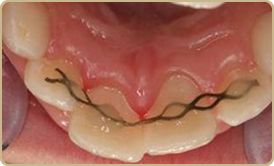
Tooth replantation refers to the reinsertion and splinting of a tooth that has been avulsed (knocked or torn out) of its socket.
Teeth are replanted to prevent permanent loss of the tooth. The success of replantation depends on the vitality of the cells remaining on the root surface. In normal conditions, a tooth is connected to the socket by means of the periodontal ligament. When a tooth is knocked-out, that ligament stretches and splits in half. Maintaining the vitality of the cells that remain attached to the root surface is the key to success following replantation.

Dental avulsion is a real dental emergency in which prompt management (within 20–40 minutes of injury) decides the probability of success of replantation. The avulsed permanent tooth should be gently but well rinsed under tap water, with care taken not to damage the surface of the root which may have living periodontal fibre and cells. Once the tooth and mouth are clean, an attempt can be made to re-plant in its original socket and later splinted for several weeks. One week to ten days after the replantation, the dental pulps of the replanted teeth are removed and a root canal treatment completed later within two months.